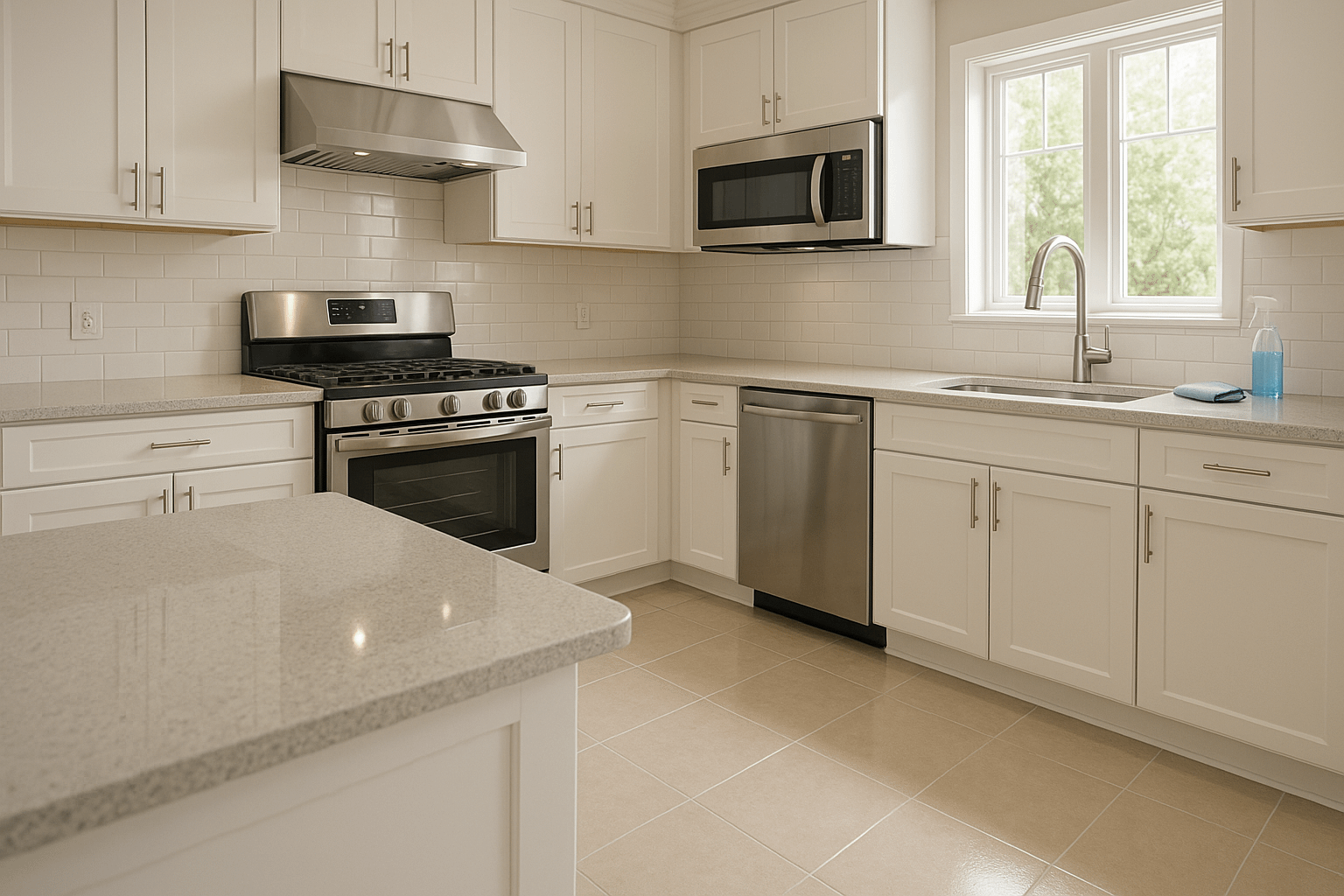Table of Contents
Keeping the kitchen clean can be a daunting task, but it is a necessary one for maintaining a healthy and organized space.
In this guide, we will discuss tips and tricks for quick and efficient kitchen cleaning, as well as techniques used by professional house cleaners. From decluttering and deep cleaning to maintaining a daily routine, these steps will help you achieve a spotless kitchen like a pro.
So let’s dive in and learn how to clean your kitchen like a pro!
Declutter and Organize
When it comes to giving your kitchen a thorough cleaning, it’s essential to start by decluttering and organizing the space. This means clearing out all the items from your countertops, cabinets, and pantry.
Take the time to go through each item and assess what you truly need and what can be removed.
Once you’ve decluttered, think about the most efficient way to organize your remaining items. Consider using storage containers, drawer dividers, and labeled baskets to keep everything tidy and easily accessible.
By creating a well-organized kitchen, you’ll not only make the cleaning process easier, but you’ll also have a more functional and efficient space for cooking and baking.
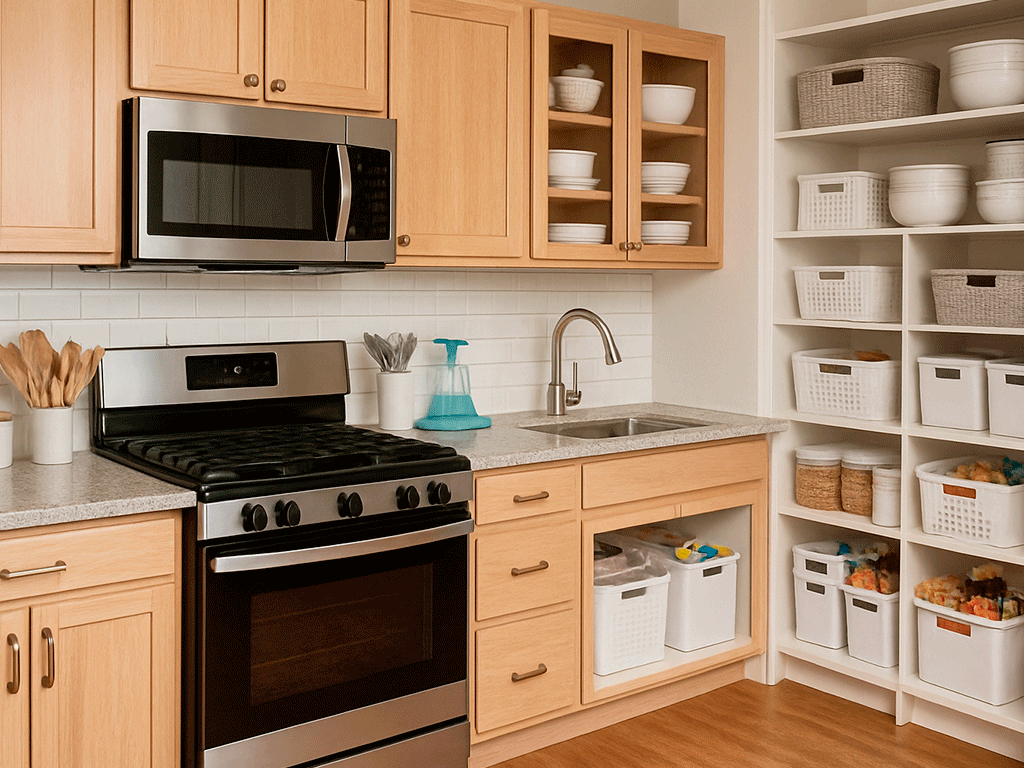
Furthermore, when organizing your kitchen, be mindful of grouping similar items together. For example, keep all your baking essentials like flour, sugar, and baking pans in one area, and store your cooking oils, spices, and utensils in another. This can save you time when you’re preparing meals and reduce the likelihood of ingredients getting misplaced or overlooked.
Additionally, think about the most frequently used items and ensure they are stored in easily accessible locations, so you don’t have to reach for them from the back of a cabinet every time you cook.
Ultimately, a well-organized kitchen will not only make it a pleasure to work in, but it will also make the cleaning process more efficient and less time-consuming.
Gather Your Cleaning Supplies
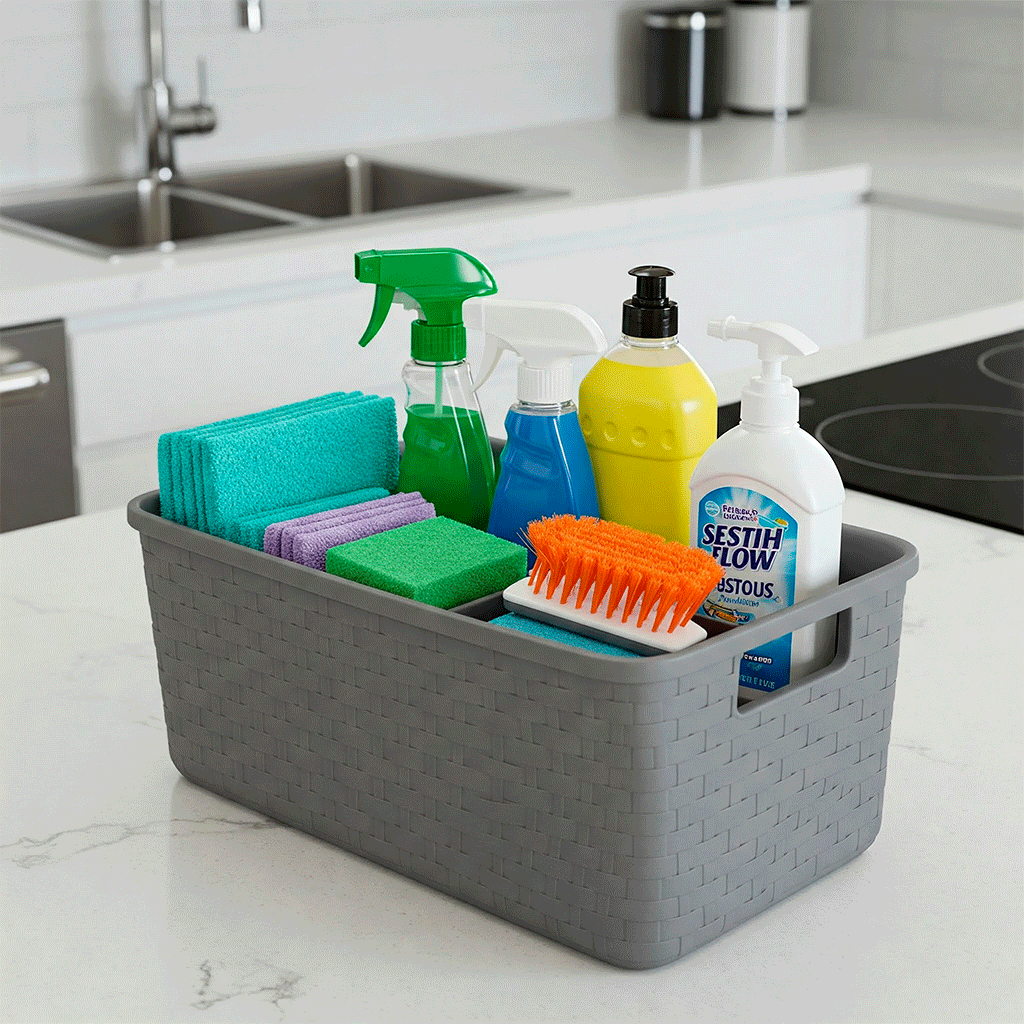
Before diving into the cleaning process, it’s crucial to gather all the necessary cleaning supplies.
Having the right tools and products on hand can make the task of cleaning your kitchen much more manageable. Start by collecting items such as microfiber cloths, sponges, a durable scrub brush, and a mop and bucket.
In addition to these tools, make sure you have a good all-purpose cleaner, baking soda, white vinegar, dish soap, and a disinfecting spray for tackling germs and bacteria. It’s also important to have a reliable and powerful degreaser for stubborn kitchen grease, as well as specific cleaners for your appliances, such as stainless steel or glass cooktop cleaners.
Having a caddy or portable cleaning basket to store all your supplies can be incredibly helpful, as it allows you to easily carry your products from one area of the kitchen to another. This can save you time and effort, especially when you’re in the middle of a cleaning task and need to reach for a specific item. By having all your cleaning supplies readily available and organized, you can streamline the process and ensure that nothing is overlooked during your kitchen cleaning routine.
Clean Appliances
When it comes to cleaning your kitchen, giving special attention to your appliances is essential. Start with your refrigerator, and take the time to empty it completely, checking for any expired or spoiled items. Wipe down all the interior surfaces with a mixture of warm, soapy water, and use a vacuum or soft brush attachment to clean the coils and vents.
Don’t forget to clean the exterior as well, including the handles, doors, and any other surfaces prone to fingerprints or spills. Moving on to the microwave, you can steam clean the interior with a mixture of water and vinegar, or use a microwave-safe cleaner to remove any stubborn food splatters.
Next, focus on your kitchen’s essential appliances, such as the oven, stovetop, and dishwasher. For the oven, consider using a specialized oven cleaner to tackle any built-up grease or food residue. The stovetop can be cleaned with a specific cleaner designed for the type of surface you have, whether it’s gas, electric, or induction.
Finally, for the dishwasher, it’s important to regularly clean the interior, including the filter, and to run a specialized cleaner through a cycle to eliminate any lingering odors or residue. By dedicating time to clean each of these appliances thoroughly, you can maintain their performance and prolong their lifespan while also ensuring a spotless and hygienic kitchen environment.
Wipe Down Surfaces
After decluttering and organizing, it’s time to tackle the surfaces in your kitchen.
Start by using a microfiber cloth or a non-abrasive sponge to wipe down all the countertops, paying special attention to any areas with spills, stains, or stickiness. Use a suitable surface cleaner or a mix of warm, soapy water to effectively remove any dirt or residue.
Additionally, don’t forget to clean the various other surfaces in your kitchen, such as the hood, backsplash, and cabinet doors. These areas can often be overlooked but are prone to accumulating grease, cooking splatters, and fingerprints, so regular cleaning is essential to maintain a pristine and inviting kitchen space.
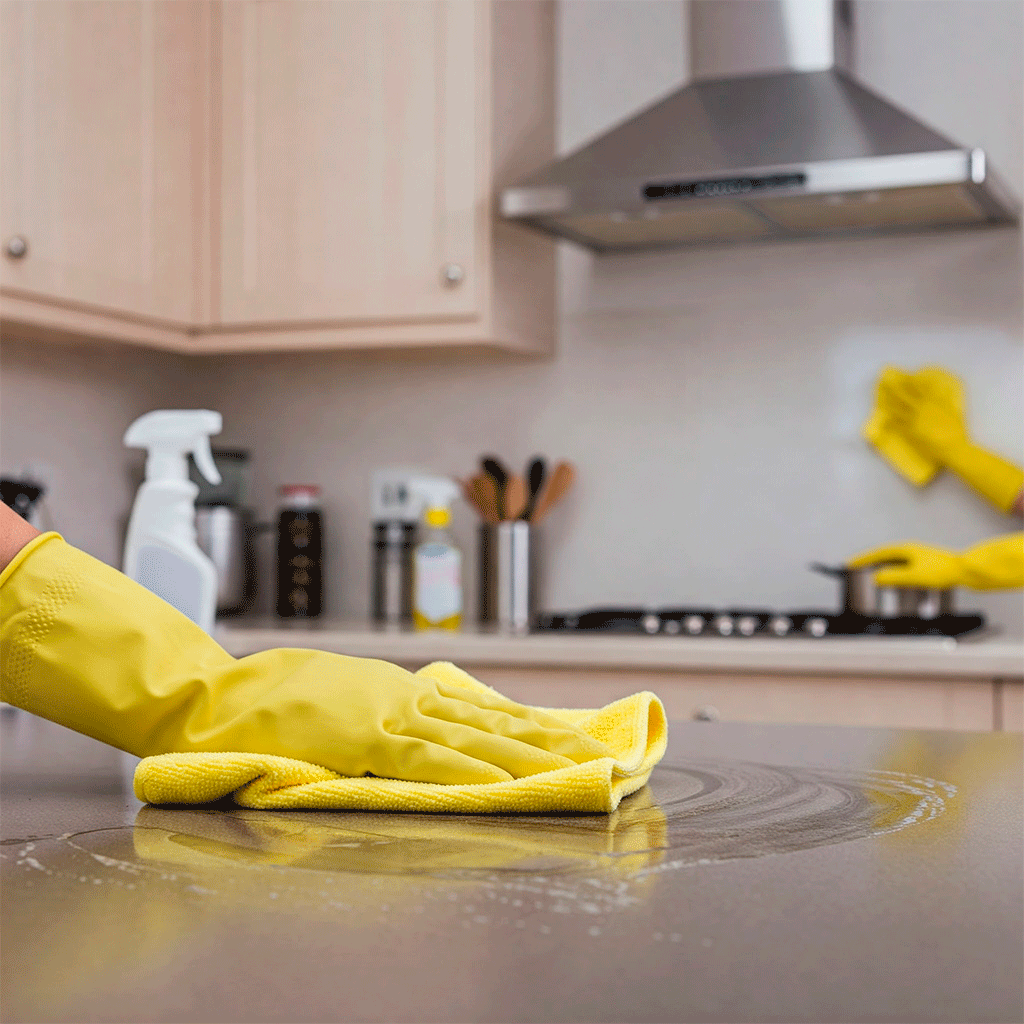
For the more delicate surfaces, such as stainless steel appliances or glass cabinet doors, make sure to use cleaning products specifically designed for these materials to avoid any damage or streaking.
It’s also a good idea to pay attention to commonly touched areas, like light switches, drawer handles, and cabinet knobs, as they can harbor germs and bacteria. By incorporating a comprehensive surface-wiping routine into your kitchen cleaning regimen, you can create a clean, sanitized, and welcoming environment for both you and your family.
Scrub the Floors
The floor of your kitchen is undoubtedly one of the hardest-working surfaces in the home, constantly exposed to spills, crumbs, and stains. To ensure a thorough clean, start by removing any rugs or mats and giving the floor a good sweep or vacuum to remove loose debris.
Then, prepare a cleaning solution suitable for the type of flooring in your kitchen, whether it’s tile, laminate, or hardwood. Using a mop, gently scrub the floor, paying extra attention to high-traffic areas and any spots with stubborn stains or buildup. For added sanitation, consider using a disinfectant floor cleaner, especially in areas where food is prepared or consumed.
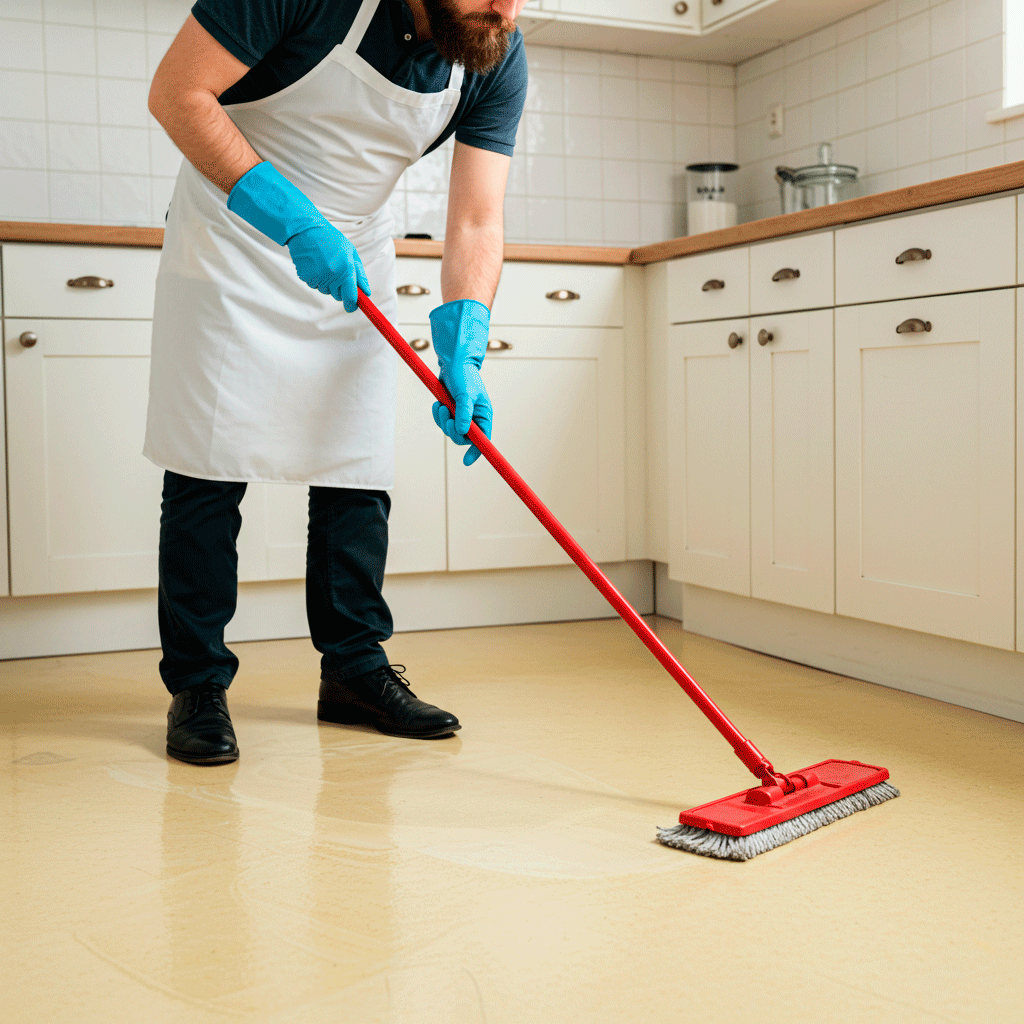
After mopping, allow the floor to air dry completely before replacing any rugs or mats, and take the time to inspect the edges and corners for any remaining dirt or grime.
These areas are often overlooked but can harbor hidden messes if not cleaned regularly. Additionally, consider a more in-depth floor cleaning, such as a steam cleaning or professional deep clean, on a less-frequent basis, especially if your kitchen is subjected to heavy daily use. By giving your kitchen floor a thorough scrubbing and incorporating it into your regular cleaning schedule, you can ensure that it’s not only visually clean but also hygienic and free from accumulated dirt and bacteria.
Deep Clean the Fridge

When it comes to maintaining a clean and efficient kitchen, the refrigerator often requires special attention.
Start by emptying all the contents from the fridge and checking for any expired or spoiled items.
Pay close attention to any spills or stains on the shelves and walls, and use a suitable cleaner to wipe down the interior surfaces. Don’t forget to clean the fridge’s exterior as well, including the handles, doors, and any other areas that tend to accumulate fingerprints or smudges.
Additionally, take the time to double-check and reorganize the items inside the fridge, grouping similar items together and ensuring that everything is stored in an easily accessible and logical manner.
Furthermore, as part of your deep cleaning routine, consider removing and cleaning the fridge’s shelves, drawers, and any removable components. This can help eliminate any hidden spills or crumbs and ensure that the entire interior of the fridge is hygienic and presentable. Pay attention to the area around the base of the fridge, as well, as dust and debris can accumulate in this often-forgotten space.
Finally, regularly inspect the contents of your fridge to monitor food labels and promptly remove any items that are past their expiration dates to prevent food waste and maintain a clean and organized refrigerator.
Deal with Stains
Stains and spills are inevitable in the kitchen, so it’s crucial to deal with them promptly to prevent any long-lasting damage or residue. Whether it’s a stubborn food stain on your countertop, a splash mark on your stovetop, or a lingering water ring on a wooden surface, knowing the right techniques to remove these stains is essential.For most surfaces, a mixture of baking soda and water can be a gentle yet effective way to tackle tough stains without causing damage.
Apply the paste to the stain, let it sit for a while, and then gently scrub it away with a soft cloth or sponge.
For more resilient stains or spill marks, consider using specialized cleaners or techniques recommended for the specific surface material, such as vinegar for glass, or a degreaser for kitchen grease.
In the case of burnt food on the stovetop or in the oven, a thorough and persistent scrubbing with a dedicated oven cleaner or a baking soda paste can help lift away even the most stubborn residues. By promptly addressing stains and spills as they occur and knowing the most effective and safe methods to remove them, you can maintain the surfaces in your kitchen in pristine condition and prevent the accumulation of unsightly and potentially damaging marks.
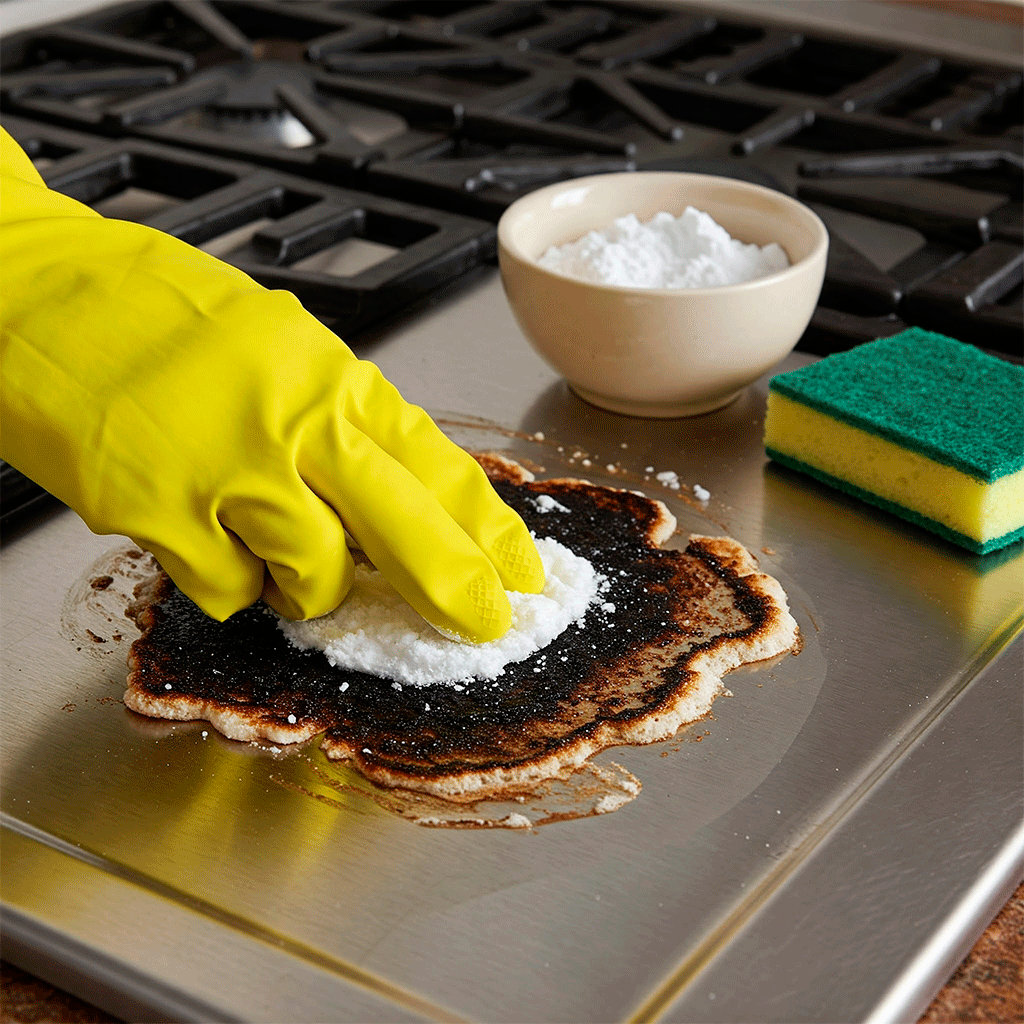
Maintain a Daily Cleaning Routine
Amid the larger, occasional deep cleaning tasks, it’s important to establish a daily cleaning routine to maintain the cleanliness and order of your kitchen on a regular basis.
Make it a habit to clear away and wipe down surfaces after every meal, and encourage a clean-as-you-go approach when preparing and cooking food. This can significantly reduce the amount of time and effort required for your larger cleaning sessions and help prevent the buildup of messes and grime. Furthermore, consider implementing a daily tidying-up routine, such as quickly sweeping or spot-mopping the floor and doing a quick inventory of the fridge and pantry to identify any items that need attention.
Incorporate small, manageable tasks, such as emptying the dishwasher, taking out the trash, and restocking cleaning supplies, into your daily routine to ensure that they don’t become overwhelming chores. Additionally, involve the whole family in the daily upkeep of the kitchen to share the responsibility and maintain a consistently clean and organized environment.
By prioritizing a daily cleaning routine and consistently attending to the small tasks, you can prevent the kitchen from becoming a daunting cleaning project and create a welcoming and hygienic space for your daily activities and culinary endeavors.
Conclusion
In conclusion, with the help of these professional cleaning techniques, tips and tricks, you can easily and efficiently deep clean your kitchen like a pro. By following a regular cleaning routine and properly maintaining appliances and surfaces, you can keep your kitchen spotless and save time in the long run.
With a little bit of effort and the right supplies, you can have a clean and clutter-free kitchen that is ready for all your cooking and dining needs.
